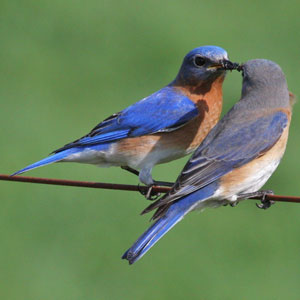Magazine | Études
Fientes fluorescentes et corridors biologiques

Merlebleus de l’Est (Sialia sialis).Photographie : Sandysphotos2009 / Wikimedia Commons
Introduction
La notion de « corridor biologique » est un concept très populaire dans le domaine de la gestion de l’environnement : il s’agît d’un ensemble de structures généralement végétales, en milieu terrestre ou humide permettant les dispersions animales et végétales entre différents habitats (massifs forestiers, zones humides…). Mais il est parfois difficile de savoir si ces couloirs sont vraiment utilisés par les animaux pour lesquels ils ont été mis en place.
Le numéro de juin 2005 de la revue Science a présenté une expérience très intéressante conduite au sein une population de Merlebleus de l’Est (Sialia sialis) : on leur a fourni des baies de myrtes enduite d’une substance permettant de rendre les fientes fluorescentes lorsqu’elles sont soumises à une lumière U.V. afin d’identifier les « couloirs » qu’ils utilisent pour se déplacer entre les habitats favorables.
Abstract
Energy facility near Aiken, South Carolina, have found a new method for tracking birds : to give them artificially fluorescent fruit. They have tested the method on Eastern bluebird (Sialia sialis). Then biologists just have was to follow the glowing droppings to discover how the birds use « corridors » to travel between habitats. They coated the fruits of the wax myrtle (Myrica cerifera) bush with a diluted form of sticky Wiltproof-an agricultural adhesive to which fluorescent powder binds. The birds then obligingly dropped their feces into well-placed plastic flowerpots near popular perches throughout a large, wooded test area. In the pots, fluorescent undigested pulp and seeds were visible under a flourescent scope.
The project area covered hundreds of acres. Fruit-rich wax myrtle bushes were situated in a central patch, while several areas of mature pine forest were cleared to create shrubby meadows, each about the size of a football field. The fields were separated by hundreds of meters of pine forest. Some were connected with corridors, while others were not. The birds did indeed use the corridors. The proof: Researchers found much more fluorescent droppings in the connected habitat areas than in those that were isolated.
The study was published in the issue of June 2005 of the journal Science.
Poursuivez la lecture de cet article, en vous abonnant dès maintenant !
Découvrez les Archives d’Ornithomedia.com
Pour seulement 10,00 €TTC/an (ou 6,00 € les 6 mois)
Profitez de plusieurs centaines d’articles en accès illimité et sans aucun engagement.
Compléments
Ouvrages recommandés
- National Geographic Field Guide to the Birds of Western North America de Jon L. Dunn et Jonathan Alderfer (21 octobre 2008)
- Where the Birds Are: The 100 Best Birdwatching Spots in North America de National Wildlife Federation
- The Sibley Guide to Birds de D. Allen Sibley




Aucun commentaire sur ce sujet
Participer à la discussion !